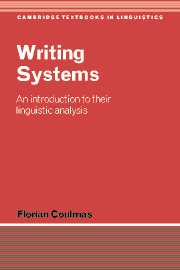Book contents
- Frontmatter
- Contents
- List of illustrations
- List of tables
- Acknowledgements
- A note on fonts
- List of abbreviations and conventions
- 1 What is writing?
- 2 The basic options: meaning and sound
- 3 Signs of words
- 4 Signs of syllables
- 5 Signs of segments
- 6 Consonants and vowels
- 7 Vowel incorporation
- 8 Analysis and interpretation
- 9 Mixed systems
- 10 History of writing
- 11 Psycholinguistics of writing
- 12 Sociolinguistics of writing
- Appendix: Universal Declaration of Human Rights, article 1
- Bibliography
- Index of names
- Index of subjects
9 - Mixed systems
Published online by Cambridge University Press: 05 June 2012
- Frontmatter
- Contents
- List of illustrations
- List of tables
- Acknowledgements
- A note on fonts
- List of abbreviations and conventions
- 1 What is writing?
- 2 The basic options: meaning and sound
- 3 Signs of words
- 4 Signs of syllables
- 5 Signs of segments
- 6 Consonants and vowels
- 7 Vowel incorporation
- 8 Analysis and interpretation
- 9 Mixed systems
- 10 History of writing
- 11 Psycholinguistics of writing
- 12 Sociolinguistics of writing
- Appendix: Universal Declaration of Human Rights, article 1
- Bibliography
- Index of names
- Index of subjects
Summary
We are like sailors who must rebuild their boat on the open sea without ever being able to take it apart in a dock and reassemble it from scratch.
Otto NeurathScripts which have evolved over long periods as the everyday writing systems of whole speech-communities or nations are almost always something of a mixture.
Geoffrey SampsonOne of the many extraordinary features of Han'gŭl is its uniformity and systematic purity. Each Han'gŭl sign, that is, each unit of interpretation, relates to the same kind of linguistic unit, a syllable, in the same manner by building it up from smaller components, which in turn relate to parts and aspects of the articulated sound stream in a uniform manner. This makes Han'gŭl one of the most systematically coherent scripts ever invented and used. Most other writing systems are much less consistent, incorporating as they do a variety of units and relying on a variety of mapping relations for interpretation. The reasons for this lie in the principle of historicity, which, as pointed out in chapter 1, is common to all writing systems. From their inception to their mature form all writing systems have gone through an extended process of evolution, often retaining features of earlier stages. New features were added, others discarded, as the system evolved alongside, but not necessarily in close connection with, the language it was first used to write. As a consequence, the mapping relation with the language underwent changes, too, often getting more complicated.
- Type
- Chapter
- Information
- Writing SystemsAn Introduction to Their Linguistic Analysis, pp. 168 - 189Publisher: Cambridge University PressPrint publication year: 2002



